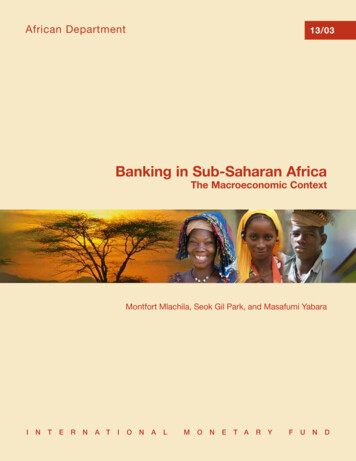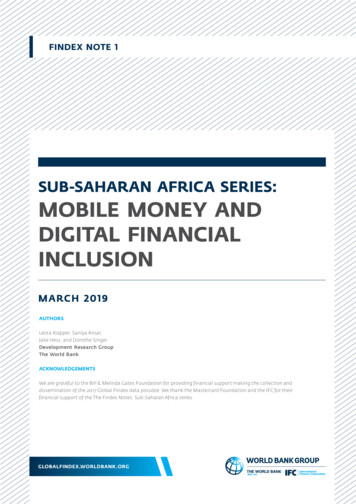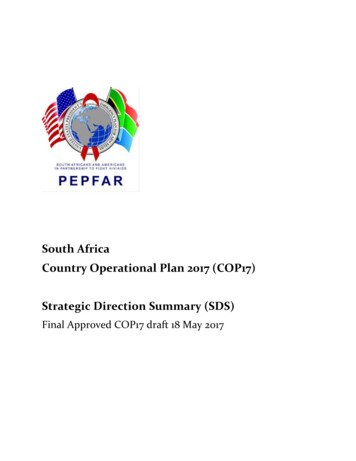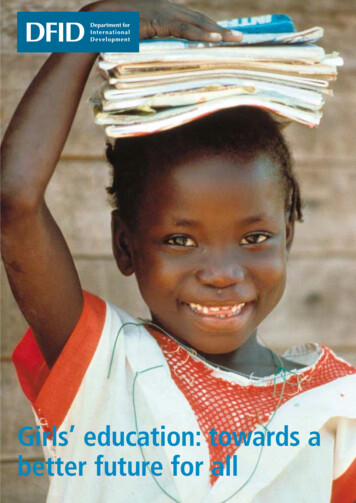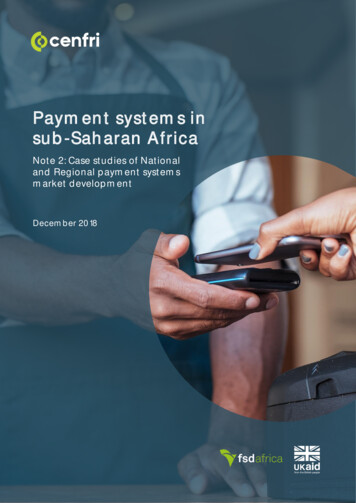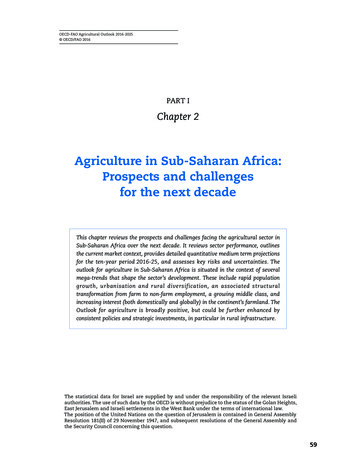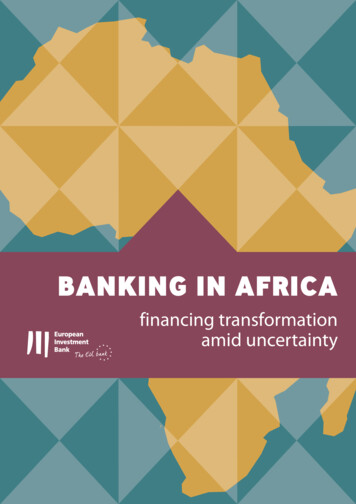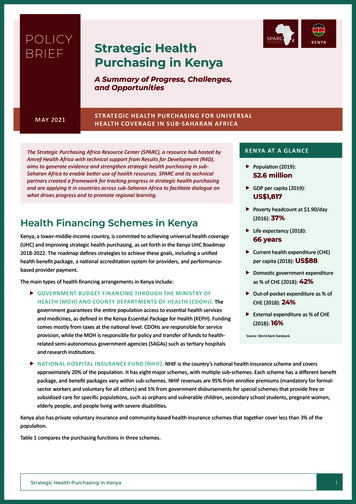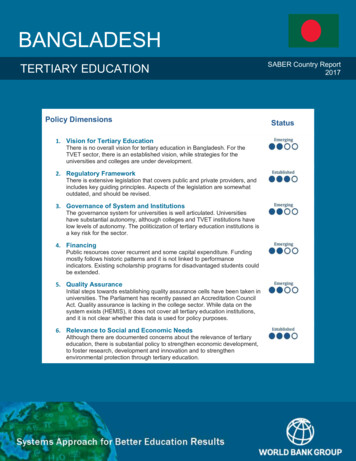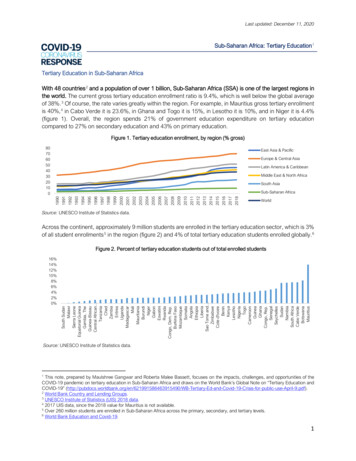
Transcription
Last updated: December 11, 2020Sub-Saharan Africa: Tertiary Education 1Tertiary Education in Sub-Saharan AfricaWith 48 countries 2 and a population of over 1 billion, Sub-Saharan Africa (SSA) is one of the largest regions inthe world. The current gross tertiary education enrollment ratio is 9.4%, which is well below the global averageof 38%. 3 Of course, the rate varies greatly within the region. For example, in Mauritius gross tertiary enrollmentis 40%, 4 in Cabo Verde it is 23.6%, in Ghana and Togo it is 15%, in Lesotho it is 10%, and in Niger it is 4.4%(figure 1). Overall, the region spends 21% of government education expenditure on tertiary educationcompared to 27% on secondary education and 43% on primary education.Figure 1. Tertiary education enrollment, by region (% gross)80706050403020100East Asia & PacificEurope & Central AsiaLatin America & CaribbeanMiddle East & North AfricaSouth 19941993199219911990Sub-Saharan AfricaWorldSource: UNESCO Institute of Statistics data.Across the continent, approximately 9 million students are enrolled in the tertiary education sector, which is 3%of all student enrollments 5 in the region (figure 2) and 4% of total tertiary education students enrolled globally. 616%14%12%10%8%6%4%2%0%South SudanMalawiSierra LeoneEquatorial GuineaGambia, TheGuinea-BissauCentral African taniaBurundiNigerGabonEswatiniRwandaCongo, Dem. Rep.Burkina FasoMozambiqueSomaliaAngolaEthiopiaLiberiaSao Tome and ZimbabweCote GhanaCongo, Rep.SenegalSeychellesSudanNamibiaSouth AfricaCabo VerdeBotswanaMauritiusFigure 2. Percent of tertiary education students out of total enrolled studentsSource: UNESCO Institute of Statistics data.1This note, prepared by Maulshree Gangwar and Roberta Malee Bassett, focuses on the impacts, challenges, and opportunities of theCOVID-19 pandemic on tertiary education in Sub-Saharan Africa and draws on the World Bank’s Global Note on “Tertiary Education andCOVID-19” e-April-9.pdf).2World Bank Country and Lending Groups.3UNESCO Institute of Statistics (UIS) 2018 data.42017 UIS data, since the 2018 value for Mauritius is not available.5Over 260 million students are enrolled in Sub-Saharan Africa across the primary, secondary, and tertiary levels.6World Bank Education and Covid-19.1
Last updated: December 11, 2020Impact of COVID-19 on Tertiary Education in SSAThe countries of Sub-Saharan Africa took significant steps to respond to the COVID-19 pandemic soon afterthe first few cases appeared and started imposing countrywide lockdowns starting in mid-March. As ofDecember 1, 2020, the total number of COVID-19 cases detected via testing in the region was approximately1.5 million, with 32,561 deaths recorded at that time. 7 Half of the countries in the region, are still closed forlearning for approximately 4 million tertiary education students. Some of these students, apart from learning,continue being without essential facilities such as dormitories, on campus jobs, and internet access. In severalcases in the region, universities are also struggling tomeet the required health protocols issued by theirnational health officials to allow in-person classes andBox 1. Universities want to double tuition feeshence why they remain closed for in-person classes.from next year in Kenya. The vice-chancellorswant all state-sponsored students to pay annualGovernment cuts to education budgets and feetuition fees of US 600, up from the currentincreases are further adding to the impact and likely toUS 265. This could earn public universities atleast US 450 million annually, which is expectedworsen. In Kenya, the Commission on Universityto fund their operations and developmentEducation reallocated K Sh 272 million (US 2.5 million) 8expenditures. Private universities are alsoof its development cash to a COVID-19 emergencyseeking to double their fees from the currentfund. There is also a proposed cut of K Sh 3.9 billionUS 700 to US 1,400 a year.(US 36.4 million) from the Basic Educationdepartment. 9 In Nigeria, the federal government plansUniversity World Newsto cut 26.51 billion (US 68 million) from the basichealth care sector and 50.76 billion (US 130 million)from the education sector 10 to support their pandemicresponse initiatives. Kenya is also proposing doubling tuition fees in public and private universities which mayadd to the burden of students. (see Box 1 for Kenya)(i) Teaching and Learning. With campuses closed, colleges and universities have had no option but to deliverprograms, where possible, via online/remote platforms. This transition has exposed and continues to exposethe huge digital divide that exists among the universities, the majority of which do not have adequateinfrastructure nor techno-pedagogical capacity to deliver entire programs online. There are only a few fullyonline universities in SSA, including the African Virtual University (AVU), 11 the Witwatersrand University in SouthAfrica, and the University of Rwanda’s e-learning platform. 12 These institutions have the existing capacity andexperience to offer online programs, but they are mostly targeted toward students who want to upgrade theirskills while they are already employed, though their mandates continue to expand. Some universities that hadadequate digital infrastructure have been swift in transitioning to online teaching and learning. For example,University of Ghana rolled out its online program starting April, using the Sakai Learning Management Systemplatform. 13 Other examples include the Distance Learning Centre of Ahmadu Bello University (Nigeria), andKenyatta University’s Digital School of Virtual and Open Learning (Kenya).Instructors have been providing online classes wherever feasible, but most of the universities have neitheraccess to online learning platforms nor training in effective delivery of remote learning. Classes are beingdelivered via Skype or Zoom, for instance, which compromises the quality of learning and classroom7Refer to Annex 1 for number of cases per e-teaching-and-learning82
Last updated: December 11, 2020participation, and limits the capacity for collaborative, innovative teaching practices. Classes that requireaccess to laboratory experiments are continuing without any such intervention, using virtual laboratoryprograms where available but otherwise reverting to lectures and independent study efforts, without hands-onlab work.Access to the internet or technology is a major problem across the SSA region. With almost half of thepopulation 14 living on less than US 2 a day, internet access is limited to 25 percent 15 of the region’s population,with only 0.44 percent having access to fixed broadband. 16 Among tertiary education students, 30 percenthave access to internet at home, and 42 percent own a personal computer. The majority of this access isrestricted to the most privileged members of society. In contrast, 97 percent of tertiary education studentsreport owning a mobile phone and 74 percent own a radio, which is proportionally distributed across differentwealth quintiles. 17 Such resources are used to deliver remote education to basic and secondary level studentsand may be useful for tertiary education, as well.(ii) Research. Sub-Saharan Africa is the region with the lowest research capacity and output in the world.According to Elsevier, currently, the region contributes less than 1 percent to global research, but the regionhas the potential for tremendous growth in scientific production. Between 2012 and 2016, the number ofacademic staff papers grew by almost 43 percent. 18 A significant portion of research funding is availablethrough either European or American development agencies and other global research funding agencies,though there are very few research funding agencies in the region that are Africa-led, such as Pan-AfricanUniversity (PAU). 19To date, the COVID-19 pandemic has had a hard impact on the United States and some European countries,which are also major aid donors. National economies have already started slowing down, and they are imposingbudget cuts to their own education and research institutions. For example, in the United States, the Departmentof Education is expected to see a 12 percent cut in overall funding for FY2020, 20 in addition to cuts in studentloan programs and funding for research organizations like the National Science Foundation (NSF) and NationalInstitutes of Health (NIH). Ultimately, these countries may limit their support through aid to global researchalliances. United Kingdom has already announced an aid cut from 0.7 percent of gross national income to 0.5percent. 21 Without much locally available funding, research growth in the SSA region may slow as the continentitself is experiencing a downward trend in economic growth and the economies in the region could lose betweenUS 37 billion and US 79 billion in output in 2020 due to COVID-19. 22(iii) Exams, Graduation, and Admissions. Disruptions in classes midsemester, and with only a minority ofuniversities prepared to provide online learning, led to broad discussions of how to assess student learning toclose out the term. The ability of academic staff and of institutions to conduct exams also depends on howquickly they were able to pivot toward thoughtful remote learning modalities, including online educationalplatforms. Pass/fail assessments, open note exams, and change of final work from exams to research papersare all options being considered in lieu of traditional assessment methods. Even where universities managed todevelop online coursework and exams, with only 30 percent of students having internet access, not all wouldbe able to access the course materials or take those online exams. Without thoughtful consideration DAY?locations R.ZS?locations BND.P2?locations ZG.17PASEC data.18Africa generates less than 1% of the world’s research; data analytics can change 1/Graham gn-aid-budget-cut-chancellor-announces22See Africa’s Pulse, Issue 21, April 2020, World Bank Group, Washington, DC.153
Last updated: December 11, 2020creative problem solving, there may be delays in students receiving relevant assessments and graduating fromtheir programs.Universities are continuing to accept applications for the incoming cohort; however, further disruptions in theacademic calendars (some universities moved their new academic year to early 2021 instead ofAugust/September 2020) have slowed down student enrolment. With uncertainties surrounding the pandemic,universities should brace themselves to manage additional disruptions for the new academic year in terms ofassessments, exams, etc.(iv) Private Universities. Between 1990 and 2014, the number of private universities in the region increased ata much faster pace, from 30 to 1,000, 23 than public universities, which increased from 100 to 500. Privateuniversities in SSA rely heavily on student fees to continue their operations and may not be eligible for fundingfrom the government. In Ghana, some private institutions have not been able to pay staff salaries for Marchand April due to 50 percent unpaid student fees. 24 The current pandemic may force some of these privateuniversities to start laying off employees. For example, the University of Technology and Arts of Byumba (UTAB)in Rwanda had suspended about 40 staff members. 25 Eventually, these private universities may close due to ashortage of revenue. This can have along-term impact on the quality of tertiaryeducation in the region, eventually havingBox 2. The World Bank’s Africa Higher Education Centers ofan impact on economic development.ExcellencePotential SolutionsMeasuresandMitigationWith a huge disparity in access to digitalinfrastructure, most students in the regionare not currently able to continue theirlearning. While the COVID-19 crisispresents an opportunity for Africanuniversities to explore the potential ofintroducing technology-based platformsfor learning, most of them are presentlynot equipped with any such platformswithin their learning managementsystems. The lockdown situation furtherprevents their ability to investigate bestoptions for e-learning to implement fortheir students. The following mitigationmeasures and solutions provide shortterm and long-term actions that can betaken by tertiary education institutions inaddressing this operational gap. Some ofthese interventions can be introducedthrough active World Bank lendingoperations in the region (see Annex 2).One of the World Bank’s largest collectiveThe World Bank’s Africa Higher Education Centers of Excellence(ACE) projects aim to build the capacity of Africa’s highereducation institutions in areas that are important for the region’seconomic growth. The projects’ regional approach to highereducation—with a particular focus on postgraduate educationand applied research—aligns with Sub-Saharan Africa’s regionalintegration approach in the Africa Union’s Agenda 2063 toachieve an “integrated continent with free movement of people,goods, capital and services and infrastructure to promoteintegration.”Through addressing critical gaps in human capital and innovationin science and technology, the ACEs aim to become regionallyacclaimed research and academic institutions in their respectivefields, providing solutions to tackle regional developmentchallenges. The project embraces the importance ofindustry/sector partnerships in providing labor-market-relevanttraining, and regional and international academic partnerships inraising the quality through joint delivery of programs and sharingof resources.The participating countries include Benin, Burkina Faso, Côted’Ivoire, Djibouti, Ethiopia, Gambia, Ghana, Guinea, Kenya,Malawi, Mozambique, Niger, Nigeria, Rwanda, Senegal, Tanzania,Togo, Uganda, and Zambia.Summarized by project teams based on Project Appraisal /post.php?story s.com/post.php?story 20200422115630505.244
Last updated: December 11, 2020lending operations is the Africa Centers of Excellence initiative, which spans four discrete projects across 19countries and 51 tertiary education institutions in the region (see box 2).(i) Needs assessment. In the short or medium term, it is important to assess the preexisting capacity of theuniversities to deliver continued teaching andlearning via remote and online learning platforms,and the proportion of students and faculty that canaccess these while off-campus. In addition, it wouldBox 3. Free data packages for African students andbe important to understand the readiness of thezero-rated access to educational websitesfaculty members to deliver online content. This willSeveral universities in Africa are collaborating withensure greater connectivity and flexibility fortelecommunications companies to facilitate thecontinued learning.provision of affordable or free (zero-rated) access tothe internet for as long as the students are accessingeducation-related websites and information. WitsUniversity in South Africa is collaborating withVodacom, MTN, and Telkom to offer zero-rated accessto specific educational websites.(ii) Online learning. In the short term, universitiesthat do not have access to online platforms canpromote the integration of courses availablethrough external platforms like Coursera, EdX, andFrance université numérique (FUN). Coursera andIn addition to the zero-rating agreements, theEdX offered free enrollment periods in response toUniversity of Cape Town purchased a data bundle forthe pandemic closures, allowing for interimeach student with a valid South African cell number.coverage to ensure continued student learning.Each student to receive 30 to 40 gigabytes, dependingWith built-in assessment capabilities, theseon their network provider, valid for 30 days.courses allow instructors to keep track of studentUniversity of Cape Town, South Africaprogress through the course. As many of theseMobile Telecommunications Network (MTN)options do not require continuous internet access,students even in remote areas with limited internetaccess can take courses. Makerere University’sSchool of Engineering, for example, has set upCoursera for Campus 26 hub which has provided students to take online classes as part of their creditrequirement. Since, as noted above, 97 percent 27 of tertiary education students in the region at least haveaccess to mobile phones, institutions can also provide funding for purchase of data cards for their students toensure they can access these courses. For example, the University of Ghana is already offering 10-gigabytedata bundles to its students to switch to online classes (see box 3). Some universities have partnered withtelecom companies to provide subsidized data bundles for their students. For example, the University of Nairobihas partnered with Telkom Kenya to provide Soma na Telkom cheaper data bundles for its staff and studentsacross 13 campuses nationwide. Additionally, the Association of African Universities, through the AfricaCenters of Excellence for Development Project has provided several capacity building webinars including useof e-learning and digital materials including digital pedagogy.To address the techno-pedagogical issue, the World Bank in collaboration with the École PolytechniqueFédérale de Lausanne ‐ EPFL (Switzerland) is launching the Unit of Competence in Digital Education (U-CoDE)Initiative to train more than 200 academic staff, pedagogical engineers and digital education technicians. ThePilot initiative aims to promote the sustainable integration of digital education in the teaching process in selectedAfrican universities, to strengthen the quality of teaching as well as the competencies of kerere-university-on-coursera-punfuPASEC data.5
Last updated: December 11, 2020(iii) Connectivity. In the short term, the universities can promote the use of zero-rated access to educationwebsites among their students. Several universities have already started collaborating with telecommunicationscompanies to provide free online content (see box 3). Strengthening the National Research and EducationNetworks (NRENs) 28 in Africa is a long-term measure to address the issue of connectivity (figure 3). However,this would also require that the students have access to a laptop or a smart phone to be able to access onlinecontent on these networks. The African NRENs are relatively weak, especially in West and Central Africa.Improved connectivity could be achieved through liaising with regional telecommunications companies (MTN, 29Orange, Airtel, Vodafone), WACREN, 30 UbuntuNet Alliance, 31 and GEANT-Africonnect. 32Figure 3. Connectivity in Sub-Saharan Africa using NRENsSource: This figure was created by Alex Twinomugisha, World Bank Senior Education Specialist.(iv) Student financing. Since most countries in the region are low income, there is very limited scope forproviding stimulus packages for educational needs, especially to students. With no classes, students who areexpecting to graduate this year may do so with delays. The economic consequences of this pandemic will leadto shrunken job markets, closed businesses, and debt defaults. In the short term, national banks could considerextending the loan payment periods or canceling the debt depending on the socioeconomic status of thestudent or job availability. In the long term, public-private partnerships to provide affordable and quality tertiaryeducation could contribute to a country’s economic growth.(v) Internationalization. There are many African students studying outside the continent, primarily in the US,Europe, or China. Their education may be self-financed or supported by scholarships or work on campus parttime. With significant travel restrictions imposed across borders, some of these students are stranded abroad.Some students, having lost their temporary jobs, have fewer financial means to sustain themselves. Theincoming cohort of students (starting in September 2020) now face issues related to visa issuance. Thislooming uncertainty will lead to some students giving up their study abroad plans. For students who are alreadymid-way through their programs abroad, the universities should subsidize tuition and consider s/African NRENs/Pages/Home.aspx.Mobile Telecommunications Network.30West and Central African Research and Education Network.31The regional Research and Education Network of Eastern and Southern Africa.32GÉANT is the pan-European data network for the research and education community, and Africonnect is an Internet Service Provider inAfrica.296
Last updated: December 11, 2020students on a case-by-case basis. In the long-term, universities should develop sustainable resources forinternationalization.(vi) Sustainable financing. As mentioned, heavyreliance on student fees may either take the privatetertiary education institutions to the brink of closureor lead to drastic expenditure cuts for publicinstitutions. To continue their operations,universities should come up with a sustainablefinancing strategy. 33 This can be achieved throughmobilizing resources toward equitable enrollment,improving quality and relevance of programs,generating income through fundraising, s. Private institutions should alsoconsider setting up university endowment funds orfoundations. Examples of such universityfoundations in Africa are Ashesi UniversityFoundation in Ghana, 34 Makerere UniversityEndowment Fund in Uganda, 35 Fondation del’Université d’Abomey-Calavi in Benin, 36 and theFondation Université Cheikh Anta Diop in Senegal(see box 4). 37Box 4. Fondation Université Cheikh Anta Diop(UCAD) of SénégalThe objectives of the foundation are to (i) encourageexcellence in research and the exploitation of itsresults; (ii) contribute to the increase in the successrate of students by reducing inequalities (social,gender, disability); (iii) support students towardsuccess and socio-professional integration; (iv)strengthen and rehabilitate the heritage of UCAD; (v)contribute to improving the health, hygiene, andliving environment of students; (vi) cultivate thefeeling of belonging to UCAD; (vii) develop citizenawareness and eco-responsible behavior at thestudent level; (viii) contribute to the pacification andstability of the university space; and (ix) supportscientific, cultural, and sporting activities at UCAD.Fondation Université Cheikh Anta Diop(vii) Innovation and Research. Many African universities are continuing to innovate to produce resources thatcan help them navigate the crisis. For example, they are conducting research support for vaccine developmentand genomic sequencing of virus (see box 5), developing models to track the spread of the virus, providingBox 5. Africa contributes SARS-CoV-2 sequencing to COVID-19 trackingThree days after the confirmation of Nigeria’s first COVID-19 case, the genome sequencing results of the SARS-CoV2 specimen were announced on March 1. The sputum samples, taken from an Italian consultant who entered Nigeriathrough Lagos on February 27 before traveling to the neighboring Ogun State, were analyzed at the African Centerof Excellence for Genomics of Infectious Diseases (ACEGID) at Redeemer University. They became the first analysisof SARS-CoV-2 in Africa, signaling the continent’s contribution to the growing global body of evidence to understandthe virus’s behavior outside China.ACE for Genomics of Infectious Diseases (ACEGID – hosted at the Redeemer’s University in Nigeria) which hasdeveloped a new vaccine candidate. The WHO, in conjunction with the Africa Centre for Disease Control (ACDC),has selected ACEGID as one of the two African centers (the other in South Africa) for disease control and specializedcontinental reference sequencing research laboratories for emerging pathogens.The Scientist & World Bank Project hp?story ucad.sn/index.php/2014-03-11-12-53-25/contexte.347
Last updated: December 11, 2020voluntary medical support, raising awareness about the importance of hygiene, and producing protectiveequipment and hand sanitizers. 38 Such activities not only help generate funds but also support the localcommunity by providing affordable protective gear. Governments and university leadership should provideadditional funding for such interventions and fast-track procurement of required equipment and materials.ConclusionIt is now evident that this initial phase of disruption may persist longer than anticipated. The move toward remotelearning across tertiary education in Sub-Saharan Africa has exposed the digital divide as an additional elementof socioeconomic inequity in the region, as well as an extension of the public-private divide and the developingdeveloped divide. Universities that were able to switch more quickly to e-learning, with pedagogical andtechnological support for academic staff, have already outpaced others in the learning race. For privateuniversities, questions persist on how long they will be able to sustain themselves in this lingering academicand economic contraction, given their dependence on tuition, and public institutions may find their budgetsaffected by the national reallocation of funds from tertiary education to other funding areas such as health andsocial protection.For the instructors and learners, significant challenges remain regarding their ability to adapt to the new learningenvironment. Digital devices have become as essential as a book and a pencil, and poor families that cannotafford to invest in these digital devices face stark decisions about their capacity to enroll their children inuniversities and support them throughout the progression toward a degree. Access to and equity in persistenceand completion of tertiary education will become increasingly more challenging and require concerted focusfrom policy makers and international donors. With timely interventions from all stakeholders, the transition tothe future of learning will learn from the mistakes made and build on the successes achieved during thispandemic era to provide tertiary education that is fit for purpose for the nations of Sub-Saharan php?story 20200420091917110.8
Last updated: December 11, 2020Annex 1. Number of Cases by Country, Sub-Saharan Africa (as of December 1, 2020)Eastern and Southern wRec.Cases 560.15Comoros6117586000734.091.15Dem. Rep. 350965873.571.05Rwanda593449551615136482.360.83Sao Tome and 01891.240Somalia44511133417000296.572.54South Africa7900042153573124223025860913672.712.73South .012.02Zimbabwe99502768482128110689.112.77Western and Central wRec.Cases p/mMort.(%)Benin301543283941020262.521.43Burkina Faso28866825933000146.122.36Cabo 372217732800969.421.79Central African .065.98Cote d'Ivoire213311322096421117850.880.62Equatorial Guinea51538550090003936.671.659
Last updated: December 11, 2020Gabon9214609066231294347.710.65Gambia, lic of 40101014.82.07Sierra .982.15Source: Johns Hopkins University.Note: New Cases cases in the last 24 hours; New Deaths number of deaths in the last 24 hours; Cases P/M number of cases permillion people; Mortality Rate (%) percentage of positive cases who die.10
Last updated: December 11, 2020Annex 2.
online universities in SSA, including the African Virtual University (AVU) , 11. the Witwatersrand University in South Africa, and the University of Rwanda's elearning platform- . 12. These institutions have the existing capacity and experience to offer online programs, but they are mostly targeted toward students who want to upgrade their
